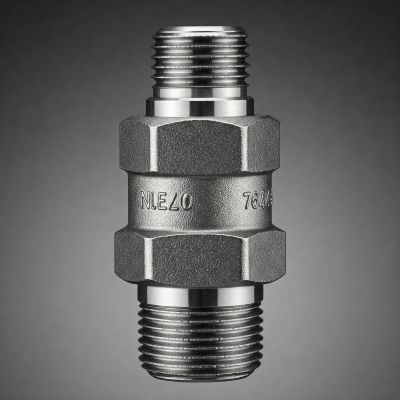National Pipe Thread (NPT) is a standard for tapered threads used on pipes and fittings in North America. These threads are crucial for creating secure, leak-tight connections in plumbing, gas, and industrial applications.
Understanding NPT specifications and sizing is essential for engineers, plumbers, and manufacturers to ensure proper installation and compatibility with different piping systems.
What is National Pipe Thread (NPT)?
NPT threads are tapered threads that create a seal through the wedging action of the thread surfaces when tightened. The taper allows for a tighter seal as the male and female threads engage, reducing the chances of leakage.
NPT threads were developed in the United States as a standardized method for joining pipes and fittings. The American National Standards Institute (ANSI) and the American Society of Mechanical Engineers (ASME) established NPT specifications under the ANSI/ASME B1.20.1 standard.
Common Industries and Applications of NPT Threads
➡️ Plumbing and water supply systems
➡️ Gas and fuel transportation
➡️ Industrial and chemical processing
➡️ Hydraulic and pneumatic systems
➡️ Fire protection and irrigation systems
Types of NPT Threads
NPT (National Pipe Tapered Thread)
NPT threads are designed with a taper of 1°47′ to create a mechanical seal. They require a thread sealant such as Teflon tape or pipe dope to ensure a leak-proof connection.
NPS (National Pipe Straight Thread)
NPS threads are straight (parallel) and do not form a tight seal without the use of O-rings or gaskets. They are typically used for mechanical connections rather than sealing.
Differences Between Tapered and Straight Threads
➡️ Tapered threads (NPT) create a seal by wedging together and require sealants.
➡️ Straight threads (NPS) do not seal by themselves and require additional sealing components like gaskets.
NPT Thread Specifications
How NPT Threads Are Measured
➡️ Nominal Pipe Size (NPS): Refers to the approximate inside diameter of the pipe.
➡️ Threads Per Inch (TPI): Determines the pitch of the threads.
➡️ Taper Angle: NPT threads have a 1°47′ taper angle for sealing.
Explanation of the 1°47′ Taper Angle
This specific taper ensures that as the threads tighten, they compress and form a leak-resistant connection.
NPT Thread Design Standards
NPT threads conform to ANSI/ASME B1.20.1, which standardizes thread dimensions, tolerances, and manufacturing requirements.
Material Considerations for NPT Fittings
➡️ Brass: Corrosion-resistant and used in plumbing and air systems.
➡️ Stainless Steel: Durable and used in high-pressure applications.
➡️ Plastic (PVC/CPVC): Lightweight and used in chemical and water applications.
NPT Sizing Guide
Standard NPT Sizes and Corresponding Pipe Diameters
|
Nominal Pipe Size |
Major Diameter (inches) |
Threads Per Inch (TPI) |
|
1/8″ |
0.405″ |
27 |
|
1/4″ |
0.540″ |
18 |
|
3/8″ |
0.675″ |
18 |
|
1/2″ |
0.840″ |
14 |
|
3/4″ |
1.050″ |
14 |
How to Determine the Correct NPT Size
Use calipers and thread gauges to measure the outer diameter and compare with standard charts.
How to Measure and Identify NPT Threads
Tools Required
➡️ Calipers (to measure outer diameter)
➡️ Thread gauges (to determine TPI)
➡️ Pitch gauges (to verify thread spacing)
Step-by-Step Guide
1. Measure the outer diameter using calipers.
2. Count the number of threads per inch using a thread gauge.
3. Compare measurements with an NPT chart.
Distinguishing Between NPT and Other Thread Types
➡️ BSP (British Standard Pipe): Has a different thread pitch and sealing mechanism.
➡️ Metric Threads: Defined by millimeters rather than inches.
NPT Thread Sealing Methods
Since NPT threads do not create a seal solely by threading, proper sealing methods are essential.
Common Sealing Methods
➡️ Teflon Tape (PTFE Tape): Wrapping threads to prevent leaks.
➡️ Pipe Dope (Thread Sealant): Liquid or paste applied to threads.
➡️ O-rings and Gaskets: Used with NPS threads for sealing.
Best Practices for Leak-Proof Connections
➡️ Apply sealant evenly without over-wrapping.
➡️ Avoid over-tightening, which can damage threads.
Common Issues and Troubleshooting NPT Threads
Cross-Threading and How to Prevent It
➡️ Ensure alignment before tightening.
➡️ Use thread gauges to verify compatibility.
Over-Tightening and Its Risks
➡️ Can cause cracks or deformation.
➡️ Reduces effectiveness of the sealant.
Solutions for Leaks in NPT Connections
➡️ Reapply Teflon tape or pipe dope.
➡️ Check for damage or worn threads.
Proper Maintenance and Inspection Tips
➡️ Regularly inspect for wear and leaks.
➡️ Replace fittings if threads appear damaged.
NPT vs. Other Thread Standards
Comparison with BSP and Metric threads:
|
Feature |
NPT |
BSP |
Metric |
|
Thread Type |
Tapered |
Parallel or Tapered |
Parallel |
|
Sealing |
Requires sealant |
Seals with mating |
Requires gasket |
|
Units |
Inches |
Inches |
Millimeters |
When to Use NPT vs. Other Thread Types
➡️ Use NPT in North American systems.
➡️ Use BSP in European and Asian markets.
➡️ Use metric threads for precision fittings.
Conclusion
Understanding NPT thread specifications and sizing ensures proper fitting selection and leak-free connections in various industries. By following standard measurement practices, using the right sealing methods, and maintaining fittings properly, professionals can achieve reliable and durable piping connections.
Post time: Mar-03-2025


